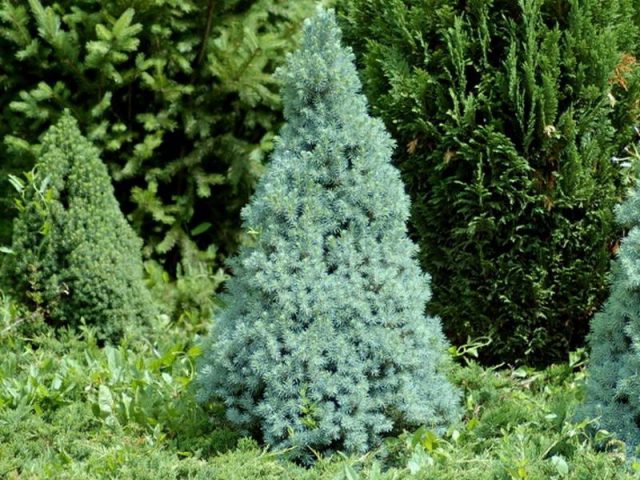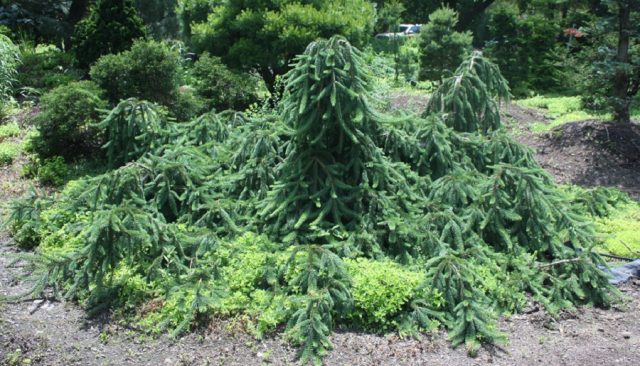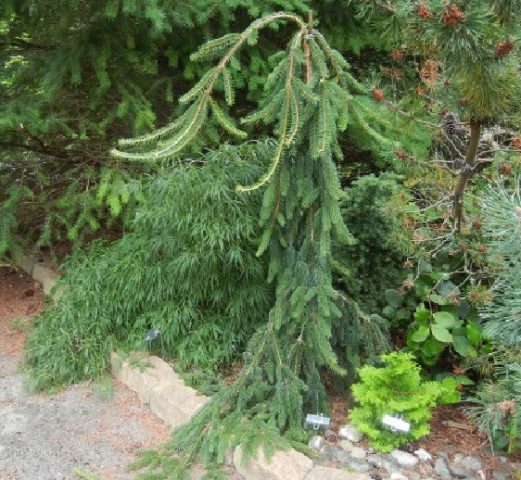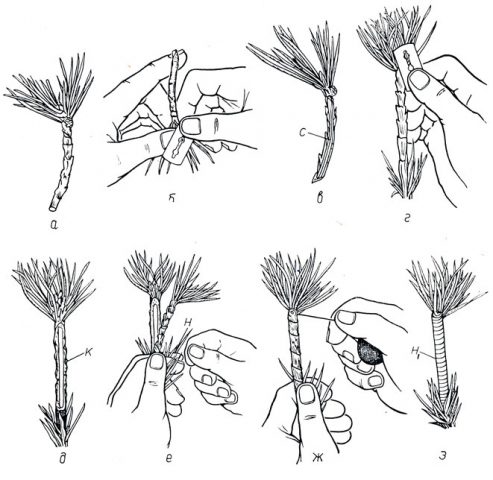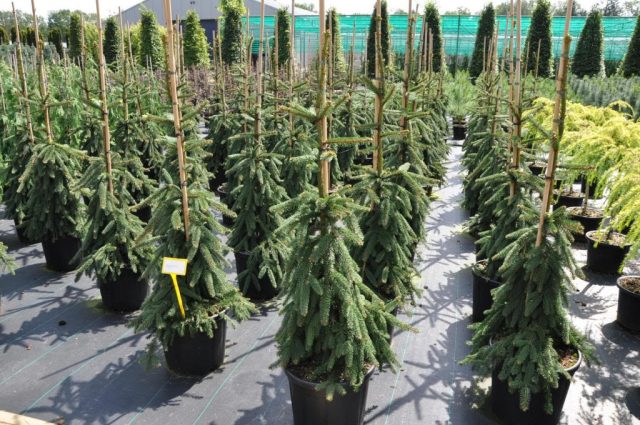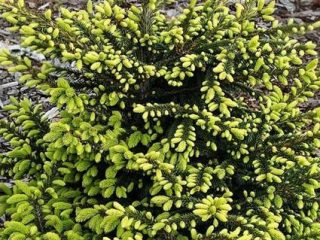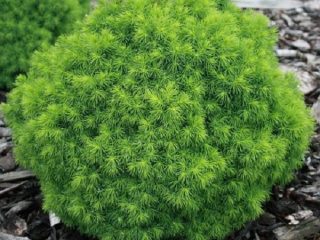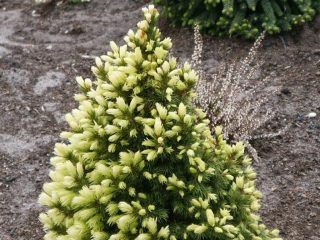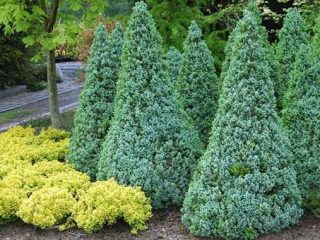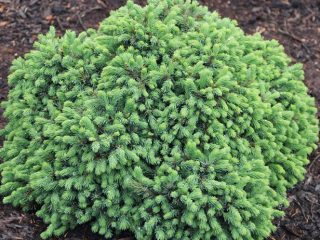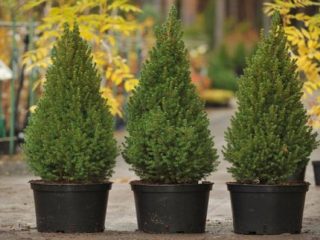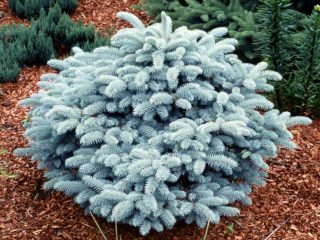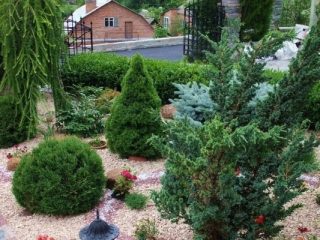Content
Beautiful conifers can become the main feature of the garden, especially in cold climates where the choice of decorative forms is not so great. Canadian spruce Pendula - a variety that has become popular due to its weeping crown, grows in frost resistance zone 3-7, but can withstand frosts down to -40 ° C (zone 2).
A strangely shaped specimen was found in the Trianon Park garden of Versailles. It was propagated by grafting, and in 1867 it was described by the botanist Elie-Abel Carriere. Unfortunately, most of the grafted weeping coniferous trees are imported to Russia, so their cost is high, and their distribution is less than it could be.
Description of the Canadian Pendula spruce
Pendula is translated into Russian as pendulum. This word can often be found in the names of varieties of deciduous and coniferous crops; it means that the tree belongs to one of three weeping forms:
- pendula – branches hang in an arc;
- reflexa – shoots bend sharply and fall;
- inversa – the branches first grow perpendicular to the trunk, then cascade down.
The Canadian Pendula spruce forms a low tree, reaching a size of 15 m at the age of 30 and giving an annual growth of 15-30 cm.By the age of 10, the variety grows to 1.5-3 m; this variation is explained by different climates and growing conditions. In Russia, Canadian spruce trees are always lower than in their homeland.
Glauca Pendula spruce has rather stiff, dense branches that bend in a steep arc near the trunk and hang down in a dense blanket. If you don't trim the lower shoots, they will fall to the ground. The crown of Pendula is compressed, narrowly conical, with drooping shoots pressed to the trunk. The needles are thick, bluish-green.
The top grows straight only if it is tied to a support. Otherwise, it leans to the side, giving the impression that the tree is bent into an arch or falling. Young shoots, formed from a whorl located on the top of the head, are first located perpendicular to the main shoot, then hang. In an adult tree, the branches are arranged in peculiar tiers. This is clearly visible in the photo of the Pendula spruce.
Spruce Pendula in landscape design
Thanks to its unique crown shape, the Canadian Pendula spruce is often planted as a single focal plant (tapeworm). It looks good in the foreground of landscape groups, next to trees or shrubs with a columnar, round or pyramidal crown.
Pendula is suitable for romantic-style gardens, recreation areas or coastal areas of artificial reservoirs. By the way, the variety will feel great near water. The bluish-green needles and weeping crown of the spruce will add expressiveness to the composition of trees and shrubs, which are highly decorative only during part of the season.
Pendula looks great planted on the lawn or along walkways. Several trees can be placed at the front entrance - they will decorate, but will not block the view of the facade of the building.
It should be taken into account that the Canadian spruce Pendula retains its average growth rate only at a young age, up to 10 years. Then it stretches out much faster. In not too large areas it can take a dominant position among ornamental crops. Since even the smallest spruce tree with side branches is already at least 4 years old, this will happen quite quickly. Before planting a tree in rockery or on a rocky hill, you need to think about what form the composition will take in a few years.
Usually weeping varieties are allowed to grow freely, but the Canadian Pendula spruce does not need this - although its branches hang down, they fit quite tightly to each other and do not interfere with other plants. But its shape greatly depends on how high the graft is made and how the main conductor was tied.
Canadian Pendula spruce trees with a standard crown are most often brought to Russia from abroad. Domestic nurseries have just begun to plant weeping conifers. In Europe and America they learned to make real miracles out of them. The photo shows the Canadian Pendula spruce on a low trunk with a freely growing crown (the main conductor not tied to the support).
Planting and caring for the gray Pendula spruce
Pendula spruce would be one of the most problem-free varieties of Canadian spruce, but it is a grafted form. Although its crown is compressed, it is not as dense as that of dwarf varieties. Therefore, cleaning the plant becomes not a vital procedure, but a cosmetic one. In the sun, Pendula burns less than most Canadian spruce trees, and at least does not become bald on the southern side. In addition, it is considered the most frost-resistant of the modern varieties of this species.
Preparing seedlings and planting area
The site for planting the Canadian Pendula spruce is chosen so that it is illuminated for at least several hours a day. The tree tolerates partial shade well; without sun at all, the bluish-green needles become dull.
Groundwater should not approach the ground surface closer than 1.5 m at the spruce planting site. The soil should be acidic or slightly acidic, permeable to air and water, and moderately fertile. It can become waterlogged for a short time, but the culture cannot tolerate drying out the roots.
Pendula spruce must be purchased at garden centers, grown in a container. Most seedlings come to Russia from abroad. If a tree has a root system lined with burlap, there is no guarantee that it was not dried out during the road. And coniferous plants die slowly; the crown remains green for more than a month even on a cut down tree.
When purchasing, you should carefully inspect the grafting site. The top of the Pendula spruce must be tied to a support.
Landing rules
The planting pit is prepared in advance. Its diameter should be several times the cross-section of the pot and be no less than 60 cm. The depth of the hole is at least 70 cm, the drainage layer of broken red brick or expanded clay is 20 cm. The planting mixture is prepared from turf soil, leaf humus, clay, sand , 100-150 g of nitroammophoska.
High-moor (red) peat is added to soils with a neutral or alkaline reaction - it not only acidifies the soil, but also improves its structure and makes it more permeable. The planting hole with drainage is 2/3 filled with the prepared mixture, filled with water and allowed to settle for at least two weeks.
You can start planting:
- So much soil is taken out of the hole so that the root collar of the Canadian Pendula spruce installed in the center is flush with the soil surface.
- Fill the hole with water and let it soak in.
- If for some reason the Pendula spruce is not tied to the support, it should be installed before planting as close as possible to the main conductor and secured. The existing one needs to be carefully examined. The garter may be too tight and sometimes digs into the bark. It needs to be replaced with a looser one.
- The root of the Canadian spruce is covered with soil, constantly compacting it to avoid the formation of voids.
- Check the position of the root collar and support (it should be directed vertically upward).
- A side is formed along the perimeter of the planting pit.
- Water the Canadian spruce abundantly with water.
- The tree trunk circle is mulched with acidic peat or fungicide-treated conifer bark. The layer must be at least 5 cm.
Watering and fertilizing
The first two weeks after planting, the soil under the Canadian Pendula spruce should not dry out. In the future, regular but moderate watering is needed. Between moistening the soil, the top layer of soil should dry out a little. Spruce Pendula does not like dry soil or stagnant water in the root area. During hot summers, the tree may require weekly watering.
The variety is relatively resistant to anthropogenic factors, but requires regular foliar feeding and treatment with epin. This helps the tree cope with air pollution.
It is recommended to fertilize roots with specialized fertilizers for coniferous plants.Nowadays it is not necessary to buy expensive imported brands - domestic manufacturers have launched cheap, high-quality drugs onto the market. So a gardener who has allowed himself to buy a weeping Canadian spruce will be able to purchase the necessary fertilizers. Fertilizers are sold separately for different seasons - spring ones contain more nitrogen, autumn ones are produced with a predominance of phosphorus and potassium.
Fertilizing is given to the Canadian Pendula spruce according to the instructions, in moist soil.
Mulching and loosening
The small roots of the Canadian Pendula spruce grow close to the soil surface and react poorly if disturbed. It is necessary to loosen the tree trunk circle only in the first two years after planting the tree, to a depth of about 5 cm. Subsequently, the soil around the spruce is mulched with acidic peat or pine bark, which is sold already treated for diseases in garden centers.
Trimming
The Canadian Pendula spruce has a beautiful weeping crown. Only branches that may appear below the grafting site need to be trimmed. Naturally, sanitary measures include the removal of broken, dry and diseased shoots.
If the design of the site requires some special shaping of the Pendula spruce, the first time the operation should be entrusted to a specialist. In the future, skilled gardeners will be able to maintain the desired contours of the crown on their own, based on the recommendations received.
The lower branches of the Canadian Pendula spruce often reach the ground and lie on the ground. To prevent infection from spreading from the soil to the tree, it should be covered with bark or ground cover plants. Otherwise, the lower shoots are cut off or shortened - they should not lie on bare soil or peat.
Preparing for winter
Pendula is one of the most frost-resistant varieties of Canadian spruce.It can even winter in zone 2. The tree needs to be covered with spruce branches or white non-woven material only for the first two years after planting. In the future, they are limited to mulching the tree trunk circle with peat, which is not removed in the spring, but embedded in the ground.
The problem is the grafting site of the Canadian Pendula spruce. In the North-West, Urals and Siberia, it should always be wrapped in non-woven material and tied with twine.
Preparation for winter of spruce consists of autumn moisture replenishment and fertilizing with fertilizers containing phosphorus and potassium.
Sun protection
Pendula prefers partial shade; in bright sun the needles can burn. It does not fall off, like dwarf Canadian spruce trees with a very dense crown, but turns brown. Needles will fall off only if no action is taken for a long time.
When planting Pendula in the sun, you should be prepared to treat the crown with epin or zircon every 2 weeks. It is better if on the south side it is slightly shaded by other plants. An adult tree (after 10 years) suffers less from the sun.
Reproduction
The Canadian Pendula spruce is propagated by grafting. The weeping shape of its crown is not inherited when sowing seeds. Cuttings also do not bring satisfactory results. The crown of a grown tree is likely to simply droop. The plant will not look like the Pendula variety.
Of course, it will be much easier to form the crown of such a tree by stretching, pruning and garters in a weeping form than with other spruce trees suitable for such an operation. But that's a completely different story.
Domestic nurseries specializing in growing conifers have already begun to graft Canadian spruce trees. A number of Russian Pendula seedlings are already on sale, but this is not enough to satisfy the market. Most of the weeping spruces come from abroad. It is extremely difficult to vaccinate them on your own, but no one forbids you to try.
Diseases and pests
The health of the Canadian Pendula spruce must be monitored with special attention, since grafted trees suffer more from fungal infections. If the disease affects the grafting site, the tree is likely to die. You need to inspect the spruce every 2 weeks with a magnifying glass, carefully moving the branches apart.
Of course, you can rely on “maybe”; it’s quite possible that everything will be fine. But then you shouldn’t be surprised if yesterday the Canadian spruce was healthy, and today a specialist invited for a lot of money reports that the tree will not survive until spring.
The Canadian Pendula spruce is often affected by snow shutte, as its branches lie on the ground. Other diseases include:
- spruce spinner;
- rust;
- stem and root rot;
- fusarium;
- necrosis of the cortex;
- ulcerative cancer.
Common pests of Canadian Pendula spruce:
- mite;
- gall aphid;
- caterpillars of the Nuns butterfly;
- mealybug;
- spruce budworm;
- hermes;
- spruce sawyer.
The crown of Pendula is not as dense as that of dwarf varieties of Canadian spruce, so it is much easier to process. Preventive spraying should be carried out regularly. Diseases that have already appeared are combated with the help of fungicides, and pests are destroyed with insecticides.
Conclusion
Canadian spruce Pendula is a very beautiful tree with a weeping crown. It will decorate any area, and requires much less care than dwarf varieties.
